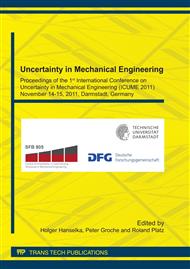[1]
G. Chryssolouris: Manufacturing Systems – Theory and Practice, Second Edition, Springer, New York, (2006).
Google Scholar
[2]
H. -P., Wiendahl, et al.: Changeable Manufacturing – Classification, Design and Operation, CIRP Annals, Vol. 56/2, (2007).
Google Scholar
[3]
D. Gerwin, Manufacturing Flexibility: A Strategic Perspective, Management Science 39(4): 395–410, (1993).
DOI: 10.1287/mnsc.39.4.395
Google Scholar
[4]
HA. ElMaraghy: Flexible and Reconfigurable Manufacturing Systems Paradigms, International Journal of Flexible Manufacturing Systems 17(4): 261–276, (2006).
DOI: 10.1007/s10696-006-9028-7
Google Scholar
[5]
YK. Son, CS. Park: Economic Measure of Productivity, Quality and Flexibility in Advanced Manufacturing Systems. Journal of Manufacturing Systems 6(3): 193–206, (1987).
DOI: 10.1016/0278-6125(87)90018-5
Google Scholar
[6]
P. Groche et al.: Increased total flexibility by 3D Servo Presses, CIRP Annals - Manufacturing Technology, Volume 59, Issue 1, (2010).
DOI: 10.1016/j.cirp.2010.03.013
Google Scholar
[7]
P. Groche, D. Fritsche, EA. Tekkaya, J. Allwood, G. Hirt, R. Neugebauer: Incremental Bulk Metal Forming. Annals of the CIRP 56(2): 635–656, (2007).
DOI: 10.1016/j.cirp.2007.10.006
Google Scholar
[8]
D. Schröder: Elektrische Antriebe 1. Grundlagen (engl. Electrical Drives 1. Fundamentals), Springer Verlag, Berlin, Heidelberg, New York, Tokyo, (1994).
Google Scholar
[9]
T. Gräbener, P. Groche, M. Kraft: Recent Developments in Servopress Technology and their Applications in Cold Forging Processes, In: 43rd ICFG Plenary Meeting 2010 September 12th to 15th, Darmstadt, Germany.
Google Scholar
[10]
J. Roske: Cold Forging with Servo Presses, Schuler Pressen GmbH & Co. KG, Göppingen, (2010).
Google Scholar
[11]
A. Osborn, S. Paul: Servo Press Technology: Drive Design and Performance, Metal Forming Magazine, Issue 8, (2008).
Google Scholar
[12]
D. Boerger: Servo Technology Meets Mechanical Presses, Stamping Journal, Nov/Dec. 2003, p.32.
Google Scholar
[13]
T. Altan: Servo-Drive Presses – Recent Developments, 10. Umformtechnisches Kolloquium Darmstadt, Verlag Meisenbach Bamberg, (2009).
Google Scholar
[14]
P. Groche, M. Scheitza: Three degrees of freedom servo-press – Conceptual design and processes for flexible forming, wt-Online, Volume 97, (2007).
Google Scholar
[15]
P. Groche, M. Scheitza: Erweiterte Fertigungsmöglichkeiten durch eine 3D-Servopresse (engl. Advanced Production Opportunities by a 3D Servo Press), Umformtechnisches Kolloquium Darmstadt, Meisenberg Bambach, (2009).
Google Scholar
[16]
S. O. Schmitt, J. Avemann, P. Groche: Development of manufacturing process chains considering uncertainty, CARV Conference Proceedings Enabling Manufacturing Competitiveness and Economic Sustainability, Springer, (2011).
DOI: 10.1007/978-3-642-23860-4_18
Google Scholar
[17]
J. Avemann, S. O. Schmitt, T. Ederer, U. Lorenz, P. Groche: Analysis of Market Demand Parameters for the Evaluation of Flexibility in Forming Technology, CARV Conference Proceedings Enabling Manufacturing Competitiveness and Economic Sustainability, Springer, (2011).
DOI: 10.1007/978-3-642-23860-4_75
Google Scholar


